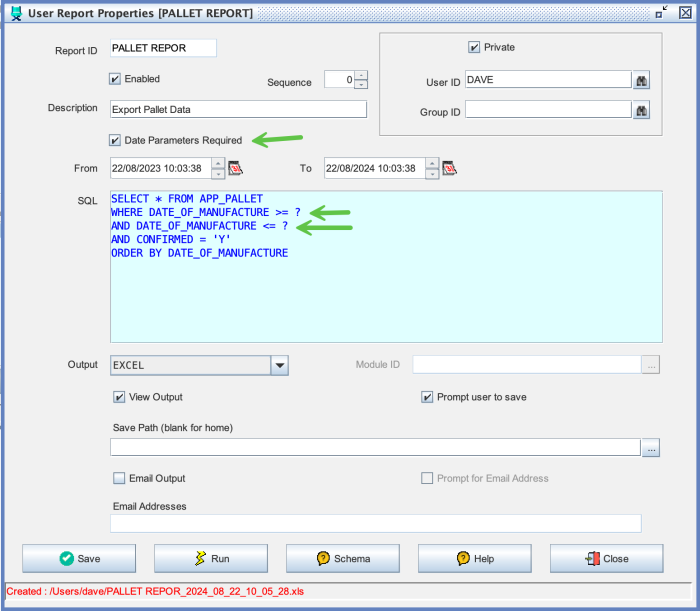Report Properties: Difference between revisions
No edit summary |
No edit summary |
||
| Line 19: | Line 19: | ||
You should be careful when creating queries which can return a great many rows. | You should be careful when creating queries which can return a great many rows. | ||
We could amend our query to look like this if we wanted to ensure that we never return more than 1000 rows. | '''''We could amend our query to look like this if we wanted to ensure that we never return more than 1000 rows.''''' | ||
MS SQL Server | MS SQL Server | ||
SELECT TOP 1000 * FROM APP_PALLET | SELECT '''''TOP 1000''''' * FROM APP_PALLET | ||
WHERE DATE_OF_MANUFACTURE >= ? | WHERE DATE_OF_MANUFACTURE >= ? | ||
AND DATE_OF_MANUFACTURE <= ? | AND DATE_OF_MANUFACTURE <= ? | ||
| Line 35: | Line 35: | ||
AND DATE_OF_MANUFACTURE <= ? | AND DATE_OF_MANUFACTURE <= ? | ||
AND CONFIRMED = 'Y' | AND CONFIRMED = 'Y' | ||
ORDER BY DATE_OF_MANUFACTURE LIMIT 1000 | ORDER BY DATE_OF_MANUFACTURE '''''LIMIT 1000''''' | ||
Oracle | Oracle | ||
| Line 42: | Line 42: | ||
AND DATE_OF_MANUFACTURE <= ? | AND DATE_OF_MANUFACTURE <= ? | ||
AND CONFIRMED = 'Y' | AND CONFIRMED = 'Y' | ||
'''''AND ROWNUM <= 1000''''' | |||
ORDER BY DATE_OF_MANUFACTURE | |||
[[file:User Reports Properties.png|700px]] | [[file:User Reports Properties.png|700px]] | ||
Revision as of 10:15, 22 August 2024
Below is an example report.
Lets say for example you want to export all pallets in the database in a certain date range.
First of all you will need to know the names of the tables and columns in the database and to assist with this you can use the Schema Browser.
The SQL statement we can experiment with is as follows :-
SELECT * FROM APP_PALLET WHERE DATE_OF_MANUFACTURE >= ? AND DATE_OF_MANUFACTURE <= ? AND CONFIRMED = 'Y' ORDER BY DATE_OF_MANUFACTURE
You will notice that in the query there are two question marks '?'. These are place holders for date paramters which you can supply at runtime.
Notice that the checkbox labelled "Date Parameters Required" has been selected.
You should be careful when creating queries which can return a great many rows.
We could amend our query to look like this if we wanted to ensure that we never return more than 1000 rows.
MS SQL Server
SELECT TOP 1000 * FROM APP_PALLET WHERE DATE_OF_MANUFACTURE >= ? AND DATE_OF_MANUFACTURE <= ? AND CONFIRMED = 'Y' ORDER BY DATE_OF_MANUFACTURE
mySQL
SELECT * FROM APP_PALLET WHERE DATE_OF_MANUFACTURE >= ? AND DATE_OF_MANUFACTURE <= ? AND CONFIRMED = 'Y' ORDER BY DATE_OF_MANUFACTURE LIMIT 1000
Oracle
SELECT * FROM APP_PALLET WHERE DATE_OF_MANUFACTURE >= ? AND DATE_OF_MANUFACTURE <= ? AND CONFIRMED = 'Y' AND ROWNUM <= 1000 ORDER BY DATE_OF_MANUFACTURE
